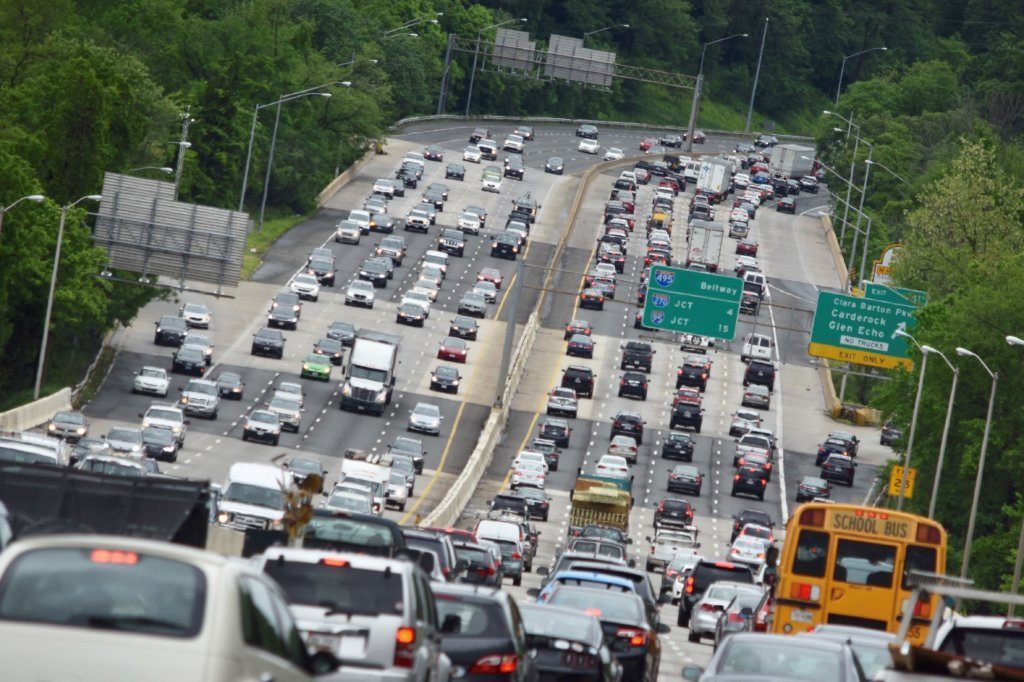
This content was republished with permission from WTOP’s news partners at Maryland Matters. Sign up for Maryland Matters’ free email subscription today.
One day after a regional transportation panel dealt a major blow to the planned widening of two interstate highways that run through Montgomery County, project backers scrambled to salvage the beleaguered plan.
“There’s major panic in the transportation industry over what happened [on Wednesday],” said Senate Majority Leader Nancy J. King (D-Montgomery), a project proponent who with speaks regularly with construction executives.
“They’re all in shock over it.”
Like many close observers of Gov. Lawrence J. Hogan Jr.’s plan to add four lanes to portions of the Capital Beltway and Interstate 270, King was caught off-guard by the Transportation Planning Board’s decision to strip the project from a required environmental analysis.
“To be able to have a vote like that happen so quickly, with all the work that’s been done on this, I think it’s devastating to our region,” King said.
The TPB operates under the Metropolitan Washington Council of Governments. The panel’s sign-off is necessary for projects that require federal approval.
D.C. Council Member Charles Allen (D), the TPB’s chairman, called the vote “a significant setback for that project. … This project is done for now.”
Hogan (R), a potential presidential candidate in 2024, has touted the privately financed Beltway/I-270 project as an example of how to foster infrastructure improvements without raising taxes.
A source familiar with the matter said on Thursday that a revised version of the project could come back for a re-vote in the next month or two.
King, whose upper Montgomery constituents battle tough traffic on I-270 seven days a week, concurred.

“There may have to be another vote,” she said. “We’ve just got to move forward.”
The motion to drop the I-495/I-270 project from the region’s Air Quality Conformity Analysis was offered by a representative of Montgomery County Executive Marc B. Elrich (D).
The proposal was supported by almost all of the county and municipal leaders from Maryland who sit on the Council of Governments’ transportation panel. Officials from the District of Columbia, Arlington and Alexandria backed it as well.
The Maryland and Virginia departments of transportation opposed it, as did many county leaders from Northern Virginia.
In an interview on Thursday, Elrich — a former county council member — said Montgomery’s continued opposition to the state’s plan centers largely around the insistence that four lanes be added to I-270. The county’s official preference for “over a decade” has been to add two reversible lanes instead.
If the state agreed to shift its approach, “then we’re into a ballpark where this is going to probably become doable,” Elrich said.
Hogan’s communications director suggested on Thursday that the county executive is not negotiating in good faith.
“I don’t think it’s just moving the goal posts. I think it’s moving the stadium at this point,” spokesman Michael Ricci said. “I believe we’re approaching the point where he’s dealing in bad faith.”
Elrich rejected that characterization. He said county leaders have opposed the addition of four lanes to I-270 since Martin O’Malley (D) was governor.
“I have an obligation to carry out and support the county’s position,” Elrich said. “Every time we’ve talked to them, we have said we want reversibles. … I continue to believe it actually solves the g—– problem.”
Elrich said Hogan appears determined to build “the most expensive project possible” to attract “somebody like Transurban.” Transurban is an Australian firm that built and financed Northern Virginia’s express toll lanes and is in line for a $54 million “predevelopment” contract on the Maryland project.
The executive has pushed Hogan and Transportation Secretary Greg Slater to seek federal funding for the new bridge, rather than do a P3. “If he’s worried about goal posts, if he would agree to that, I’ll hold the ball while he kicks it,” Elrich said.
Hogan has modified his plan to bring congestion relief to Montgomery County multiple times in the four years since he unveiled it. He has removed controversial elements, such as the widening of I-495 between the I-270 spurs and the Prince George’s border.
And he has reoriented the project so that it begins at the American Legion Bridge, a notorious chokepoint and something for which Elrich has advocated.
But the moves have failed to sway the municipal leaders, county officials and state legislators whose votes sank the project on Wednesday.
Montgomery County Planning Board Chairman Casey Anderson called the vote “the clearest indication that elected officials throughout the region have concluded that it’s politically smart — or at least not politically dangerous — to oppose this project outright.”
Many officials are hostile to the governor’s proposed “public-private partnership,” in which an international consortium adds variably-priced “express toll lanes” in exchange for the right to keep almost all of the revenue for 50 years or more. They also want a more robust transit commitment.
A former Council of Governments chairman — speaking on the condition of anonymity — said that Wednesday’s vote shifts the “leverage” in future negotiations strongly in Montgomery’s favor.
“The open question is whether or not that leverage translates into reducing the scope of the project from four new lanes to two reversible lanes” on I-270, the former official said.
The source with knowledge of the project had a different view, suggesting that Elrich could be overplaying his hand. If the Maryland-Virginia “accord” to rebuild the bridge were to die under the weight of Montgomery’s opposition, the source suggested, Elrich would be most likely to get the blame.







